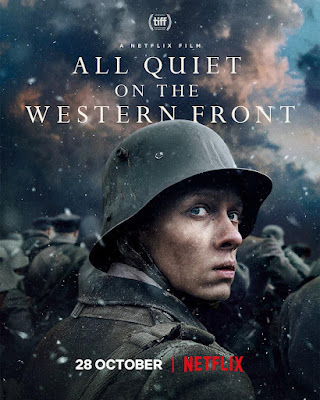October 29, 2022
It was the spring of 1917, on the third year of the war between Germany and France. In Northern Germany, there was a student Paul Bäumer (Felix Kammerer) who faked the signature of his parents to allow him to join his friends to become a soldier. After cheering a speech about service to the Fatherland, the boys excitedly donning their new uniforms, singing while marching out to be sent to La Malmaison, Northern France, 25 km to the western front.
The mood changed radically when the boys reached the trenches. Paul felt death staring right at him when he was assigned to gather the dogtags of his departed colleagues. He was able to make friends with an older soldier named Kat (Albrect Schuch) with whom he stole from farms for their food. As the death toll of German soldiers continued to rise, a politician Matthias Erzberger (Daniel Bruhl) was trying to negotiate an armistice with the sarcastic French authorities.
This film is based on a famous anti-war novel published in 1929 written by German author Erich Maria Remarque. It was immediately adapted into a film the very next year 1930 by director Lewis Milestone to critical acclaim, consistently cited as one of the best films in that era. The film won the Oscar for Best Production, the first Best Picture winner to be based on a novel. Milestone won the Oscar for Best Director, his second after winning for "Two Arabian Nights" (1927) on the first Academy Awards ceremony.
Unlike the original 1930 film (and a 1979 TV movie version), this current film is remarkable because it was produced by German filmmakers in their original language. Films about the first and second world wars are seldom told from the point of view of the Germans, so they were just perceived as "the enemy." Here we see that those young Germans soldiers also tremble or weep. They are not at all the heartless beasts they are usually portrayed. We see that there were also German officials who worked for a peaceful conclusion.
Faithful to the spirit of the book, director and co-writer Edward Berger depicted the frontlines as a bleak place of mud and grime, a place of endless uncertainty and danger, where death can happen anytime. The main character Paul was one of those nameless young soldiers whose idealism was broken by the experience of actual battle. There was no impressive displays of heroism or bravery, these men just want to survive and go back home. Yet the winds of fate constantly changed right up to the end of the war.
The destructive violence and senseless tragedy in the battlefields were caught by the beautiful cinematography of James Friend, especially those magnificent long shots of soldiers marching, running and dying across the desolate landscape. The details of the widespread carnage, with the unique injuries of each dead soldier so meticulously recreated with make-up and prosthetics, were realistic and very difficult to look at. Its strong message about the absurdity, pointlessness and stupidity of war was loud and clear. 9/10.











No comments:
Post a Comment